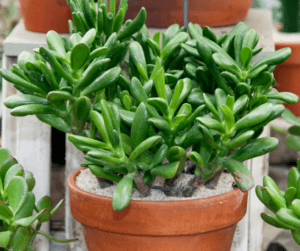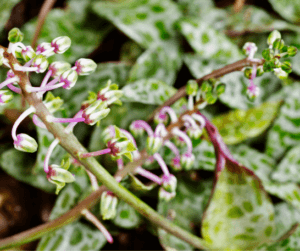Succulents are not just for sun. In fact, some of the most fascinating of these arid-habitat plants thrive in shade.
One shade-loving succulent that is familiar to anyone who has dabbled in houseplants is the western African native Sansevieria trifasciata, commonly known as snake plant. Especially well known is the variety ‘Laurentii’, with strap-shaped, 2- to 3-foot-tall leaves edged in gold. This and most of the other 60-plus cultivated varieties of Sansevieria trifasciata also feature striking horizontal banding on their thick leathery leaves, typically in alternating stripes of silver and dark green. Silver markings are strongest on varieties grown in a bit of sun, with plants becoming more uniformly green as shade levels increase.
The variety ‘Futura Superba’ much resembles ‘Laurentii’ in its coloration, but with shorter, broader leaves. Numerous other snake plant varieties come in the ‘Laurentii’ shape, including the pure silver-leaved ‘Moonshine’.

Shorter still are so-called birds-nest varieties of snake plant. These form tight low rosettes of tongue-shaped leaves, typically with silver banding (as in the popular ‘Hahnii’). The variety ‘Golden Hahnii’ adds pale-yellow leaf margins to the color scheme, while in ‘Silver Hahnii’ the leaves are nearly pure silvery gray. Other birds-nest varieties such as ‘Black Jade’ have gone to the dark side, with hues of deep green dominating their foliage. As with just about all forms of the species, birds-nest snake plants produce offspring via underground rhizomes, so there are always pups to share with friends.
Interestingly, most shade-loving succulent houseplants come from southern portions of Africa. One such species is another all-time favorite, jade plant (Crassula ovata). It slowly forms a loosely branched, rubbery-stemmed shrub, set with fleshy oval leaves that develop red-tinged margins in sun. Sunlight also often coaxes plants into bloom, with little white starry flowers clustering along the branches in winter, spring, or sometimes other seasons. However, this durable, long-lived species will also do just fine with no direct sunlight, succeeding (albeit rather gauntly) even in rather deep shade.
Jade plant is available in numerous forms, including dwarf cultivars such as ‘Baby Jade’. The Tolkien Group of jades comprises several varieties whose leaves are curled lengthwise into tubes, with cupped tips in the case of ‘Gollum’. The cultivar ‘ET’s Fingers’ is similar to ‘Gollum’, but with red-tinged leaf tips.

Native mostly to crevices and slopes of South Africa and Namibia, the 25 or so species in the genus Gasteria resemble miniature aloes, with low rosettes of small swollen triangular or tongue-shaped leaves arrayed in opposite pairs or in symmetrical whorls. The leaves typically are dotted with white waxy protuberances, and often tipped with a short spine. Plants may produce spikes of small, tubby or tubular, often brightly colored flowers, usually in winter or spring. Hybrids between Gasteria and Aloe sometimes occur in cultivation, including ‘Tarantula’, whose leaves are covered with small, white, almost hair-like spines.

Closely related to Gasteria is the larger and more diverse Haworthia, encompassing some 60 species from far-southern Africa. Their architecturally rosetted leaves come in a variety of shapes. Some such as Haworthia attenuata have narrowly triangular, white-dotted, gasteria-like foliage. Others (e.g., Haworthia retusa) bear remarkably mineral-like clusters of geometrical, crystal-shaped leaves. Another sub-group produces tight lines of flat-topped, abruptly truncated leaves that have a sawed-off appearance (these include the aptly named Haworthia truncata). Starfish-like and spherical leaf configurations also occur, as do tiered multilevel rosettes.

Haworthias are interesting rather than showy in bloom, with spikes of small white funneled flowers on relatively tall lanky stems in summer or sometimes winter.
The South African native silver squill (Ledebouria socialis) is yet another excellent subject for shaded niches. To call it a “succulent” is a bit of a stretch, but with its leathery, lance-shaped, near-evergreen leaves and drought-tolerance, it works well as an honorary member of the succulent tribe. The rosettes of erect, silvery, dark-green-dappled leaves emerge atop conical, red-skinned bulbs that are ornamental in their own right. Small-cupped pale-lilac flowers cluster atop short stems from winter into spring. Silver squill likes to grow with its bulbs mostly exposed above soil level, which adds to its unique charm.

You may have shade, but you can still have succulents! Plant the above succulents in two parts Fafard® Professional Potting Mix to one part perlite or grit. Use terracotta and do not overpot. Water only when the soil is dry, about every week or two. In addition, enjoy!

